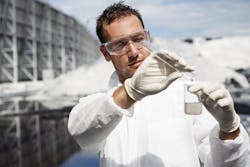Contrary to what many people think, volatile organic chemicals (VOCs) aren’t necessarily harmful, writes Dr. Joe Cotruvo in his Professor POU/POE column in the March issue of Water Technology.
"VOC" describes a chemical’s physical property. Because volatility can increase the potential for chemicals to be exposed to humans, VOCs can be health concerns is the chemical is also toxic. "The principle environmental aspects of VOCs are the ability of some to be released into outdoor air and contribute to smog due to photochemical formation of ozone in the lower atmosphere or ozone reduction in the upper atmosphere and the presence of some in drinking water from external contamination and as disinfection byproducts," says Cotruvo.
VOC examples
VOCs can be natural or synthetic. A few examples of these chemicals outlined are below.
- Isoprene (C5H8) — Produced in many forms from pine forests. Some of the variations are susceptible to other chemical processes and are very reactive with ultraviolet light. Isoprene can form terpenes, terpene derivatives and other important biologically active chemicals important for plants. It helps make the Great Smoky Mountains "smoky" because of its photochemical reactivity.
- Indoor air — Because of substances such as paint, carpets, furniture, smoking, fireplaces, laundry, showering and others, indoor air usually contains more VOCs than outdoor air.
- Industrial chemicals — Many of these are VOCs. Benzene and other solvents and tetrachloroethylene and other halogenated chemicals are regulated because they easily evaporate or distill and near ambient and slightly higher temperatures. Several industries use solvent-free and electrostatic applications to avoid using VOCs and to help stay under VOC release limitations.
- Stable VOCs — Freons and similar chlorofluorocarbon refrigerants are stable in the lower atmosphere because of their photochemical stability. They can deplete the upper level ozone when they encounter higher energy ultraviolet.
Drinking water concerns
The two main sources of VOCs in drinking water are industrial releases and chemical disinfection byproducts (DBPs), writes Cotruvo. Industrial releases primarily affect groundwater sources, while DBPs present surface water issues.
DBPs are largely generated when chemical disinfectants react with naturally occurring organic carbon. Their concentrations are usually found in parts per billion and parks per trillion or less. Depending on the water’s source, treatment and chemistry, a water sample’s total concentration is usually much less than 1 part per million.
View our infographic on common drinking water concerns.
The dominant groups of DBPs are:
- Trihalomethanes (THMs), regulated at 80 micrograms per liter (µg/l). They include:
- Chloroform
- Bromodichloromethane
- Dibromochlorimethane
- Bromoform
- Haloacetic acids regulated at 60 micrograms per liter (µg/l).
- Chloroacetic acid
- Dichloroacetic acid
- Trichloroacetic acid
- Bromoacetic acid
- Dibromoacetic acid
Regulations
The U.S. Environmental Protection Agency (EPA) established maximum contaminant levels (MCLs) for trichloroethylene, carbon tetrachloride, vinyl chloride, 1,2-dichloroethane, benzene, para-dichlorobenzene, 1,1,-dichloroethylene and 1,1,1-trichloroethane in 1987. The agency announced it would create a group regulation for carcinogenic VOCs in February 2011, and Cotruvo questions whether group regulation would have significant public impact.
EPA method 524.2 Purge and Trap Gas Chromatography/Mass Spectrometry is designated for analyze VOCs in drinking water. Airborne sample is more complex.
Exposure and treatment
Water ingestions as well as inhalation during showering and bathing can be sources of VOC ingestion. Combinations from showering and bathing can be nearly equivalent to ingestion. Dermal exposures such as swimming can also be sources of exposure.
Aeration and granular activate carbon are effective methods of VOC removal.
